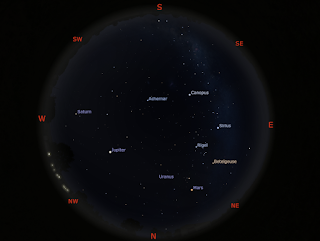Monday, December 12, 2022
Thursday December 15 to Thursday December 22
The Last Quarter Moon is Friday December 16. The Earth is at Solstice on the 22nd. Jupiter is easy to see as brightest object in the evening sky aside from the Moon. Mars is now rising well before midnight. Mars and the the red stars Aldebaran and Betelgeuse form a triangle. Mercury and Venus climb higher in the evening twilight. The Geminid meteor shower December 15.
The Last Quarter Moon is Friday December 16. The Earth is at Solstice, when the day is longest, on the 22nd.
Evening sky on Saturday, December 17 as seen from Adelaide at 20:59 ACDST, (30 minutes after sunset, click to embiggen). Venus and Mercury are low above the horizon in the twilight. You will need a low, unobstructed horizon to see them clearly.
Similar views will be seen from the rest of Australia at the equivalent
local time (30 minutes after sunset).
Mars was at opposition, when was at its biggest and brightest as seen from Earth, last week, but is still an excellent sight. The inset is the telescopic view at this time.
Similar views will be seen from the rest of Australia at the equivalent local time (90 minutes after sunset).
Saturn forms a line with delta and gamma Capricornii with Jupiter to the north-west.
The insets are the telescopic views of Saturn and Jupiter at the same magnification at this time.
Similar views will be seen from the rest of Australia at the equivalent
local time (90 minutes after sunset).
Between the bright star Canopus and the Southern Cross are another wealth of binocular objects to discover.
Elsewhere in Australia will see a similar view at the equivalent time (90 minutes after sunset).
The northern horizon at 0:30 am AEST as seen from Brisbane on Thursday December 15 when the Geminid radiant is high before Moon rise. The Geminid radiant is marked with a starburst. Similar views will be seen elsewhere in Australia at a similar latitude and the equivalent local time. (click to embiggen).
The Geminids are usually a fairly reliable meteor shower and with the
waning Moon nearby rates will not be the best, but still worth.
The Geminids have a broad peak and normally will show good activity
well before and after the peak on
the day before and after. The peak is December 13, but with the Moon almost on top of the radiant the best rates are on the morning of the 15th from around midnight until 2 -3 am. As the radiant doesn't rise until just
before midnight (daylight saving time) in most of Australia, and the Moon rises around 1:00 am you
will still have to disturb your sleep for this one.
Mercury climbs out of the twilight.
Venus climbs out of the twilight.
Mars and the the red stars Aldebaran and Betelgeuse form a triangle. Mars was at opposition, when it was biggest and brightest as seen from Earth, last week, but is still a very worthwhile sight.
Jupiter climbs higher in the late evening sky was at opposition, when it was biggest and brightest as seen from Earth, on the 27th of September. Jupiter is visible all evening.
Saturn forms a line with delta and gamma Capricornii. Saturn was at opposition, when it was biggest and brightest as seen from Earth, on the 15th of August.
Star Map via Virtual sky. Use your mouse to scroll around and press 8 when your pointer is in the map to set to the current time.
Cloud cover predictions can be found at SkippySky.
Here is the near-real time satellite view of the clouds (day and night) http://satview.bom.gov.au/
Labels: weekly sky








 Click to read about or order
Click to read about or order Click to read about or order
Click to read about or order Click to read about or order
Click to read about or order Click to read about or order
Click to read about or order




